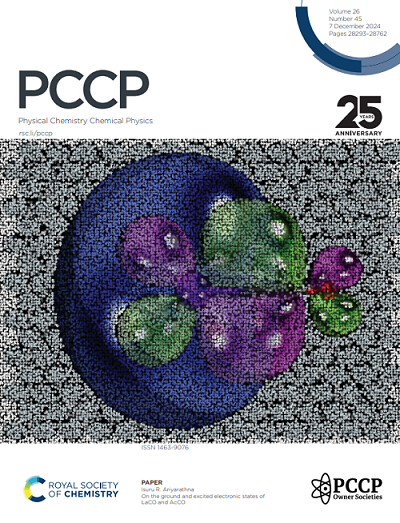The Roles of Various Fe-Cu Bimetallic Nanoclusters in Controlling the C2 Selectivity for CO Reduction Reaction - A DFT Study
IF 2.9
3区 化学
Q3 CHEMISTRY, PHYSICAL
引用次数: 0
Abstract
The unique microstructure of Cu13 nanocluster with distinct catalytic properties from general metals has been used to study the selectivity effect on oxygenated hydrocarbons. The strong synergistic promotion of Fe-Cu bimetallic nanocatalysts has been used to convert CO2 or CO to olefins via selective reduction. Unveiled by DFT, we have characterized the CO reduction capabilities of a series of Fe-Cu bimetallic nanocatalysts and further investigated to search for the possible intermediates along the CO reduction pathway. The FenCu13-n clusters with different compositions (n = 1, 2, 7, 11 and 12) are selected to represent the Cu dominant, the equal ratios, and the Fe dominant conditions in the simulations. Only the Fe-dominant clusters, particularly Fe7Cu6 and Fe11Cu2, show a preference for the formation of the COCHO intermediate. The improvement in selectivity is crucial to the successful design of catalytic systems for carbon-neutral processes. Thus, we incorporated carbon nanotubes (CNTs) to stabilize Fe7Cu6 and Fe11Cu2 nanoclusters, with the goal of enhancing the reactivity of CORR. Compared to the isolated nanoclusters, Fe11Cu2/CNT not only reduces the activation energy for CO‥CHO bond formation and the reaction energy for COCHO intermediate formation but also exhibits more stable thermodynamic properties for ethanol generation.求助全文
约1分钟内获得全文
求助全文
来源期刊

Physical Chemistry Chemical Physics
化学-物理:原子、分子和化学物理
CiteScore
5.50
自引率
9.10%
发文量
2675
审稿时长
2.0 months
期刊介绍:
Physical Chemistry Chemical Physics (PCCP) is an international journal co-owned by 19 physical chemistry and physics societies from around the world. This journal publishes original, cutting-edge research in physical chemistry, chemical physics and biophysical chemistry. To be suitable for publication in PCCP, articles must include significant innovation and/or insight into physical chemistry; this is the most important criterion that reviewers and Editors will judge against when evaluating submissions.
The journal has a broad scope and welcomes contributions spanning experiment, theory, computation and data science. Topical coverage includes spectroscopy, dynamics, kinetics, statistical mechanics, thermodynamics, electrochemistry, catalysis, surface science, quantum mechanics, quantum computing and machine learning. Interdisciplinary research areas such as polymers and soft matter, materials, nanoscience, energy, surfaces/interfaces, and biophysical chemistry are welcomed if they demonstrate significant innovation and/or insight into physical chemistry. Joined experimental/theoretical studies are particularly appreciated when complementary and based on up-to-date approaches.
 求助内容:
求助内容: 应助结果提醒方式:
应助结果提醒方式:


